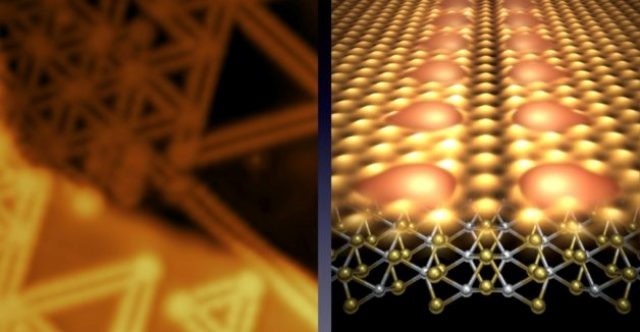May 13 2016
In the world of semiconductors, impurities and defects can be a good thing. They modify the properties of materials such as silicon, and scientists can exploit these properties to develop better transistors for laptops, smart phones, and solar cells.
 A surprise discovery in a 2D semiconductor. The left microscopy image shows linear defects that cross the 2D semiconductor like veins. The defects are located between the parallel lines. The right image is a combination of the theoretical atomic structure on the bottom, and a microscopy image on top that shows individual selenium atoms in gold and the charge density wave in red. (Credit: Berkeley Lab)
A surprise discovery in a 2D semiconductor. The left microscopy image shows linear defects that cross the 2D semiconductor like veins. The defects are located between the parallel lines. The right image is a combination of the theoretical atomic structure on the bottom, and a microscopy image on top that shows individual selenium atoms in gold and the charge density wave in red. (Credit: Berkeley Lab)
Recently, a new class of semiconductor was discovered that is only three atoms thick and which extends in a two-dimensional plane, similar to graphene. These 2D semiconductors, called Transition Metal Dichalcogenides (TMDs), have exceptional optical characteristics. They can be developed into ultra-sensitive photo detectors, and a single TMD layer emits as much light as a 3D TMD crystal composed of 10,000 layers.
For the past several years, scientists have wondered if impurities and defects could also modify TMDs’ intrinsic properties, perhaps in ways that improve the semiconductor or lead to new functionalities.
Scientists from the Department of Energy’s Lawrence Berkeley National Laboratory (Berkeley Lab) and UC Berkeley have taken a big step toward answering this question. As recently reported in the journal Nature Physics, they found—to their surprise—how substantial linear defects in TMDs create entirely new properties. Some of these properties indicate that defects in TMDs might even mediate superconducting states.
The research was conducted by Alexander Weber-Bargioni, D. Frank Ogletree, Sara Barja, Sebastian Wickenburg, Zhen-Fei Liu, and Jeff Neaton of Berkeley Lab’s Molecular Foundry. In addition, scientists from Berkeley Lab’s Advanced Light Source and Materials Sciences Division contributed to the research.
The scientists synthesized three-atom thick, clean layers of molybdenum diselenide, which is a type of TMD, at the Advanced Light Source. They then studied the material at the Molecular Foundry with a microscope that can visualize atoms and their electronic wave functions.
They discovered a linear defect formed by a line of missing selenium atoms. This defect creates one-atom thick metallic wires that cross the otherwise intact semiconductor like veins.
The scientists then cooled the material to -452 degrees Fahrenheit, which caused the atoms along the metallic wires to rearrange themselves. When this happens, the atoms’ electrons are no longer uniformly distributed. Instead, they modulate like a sinusoidal wave, while the electrons in the rest of the semiconductor remain unchanged.
“This modulation is called a charge density wave, and it’s a fascinating example of how drastically a material property can change along defects in a TMD,” says Weber-Bargioni.
The presence of a charge density wave is especially intriguing because it indicates a strong coupling between the electrons, mediated by the atomic lattice.
”And a similar strong coupling happens in superconducting states,” adds Barja. “In addition, we observed our charge density wave to still be present at temperatures well above the temperature of liquid nitrogen.”
The scientists say this poses a big question: If similar defects could be incorporated in other types of the more than 60 different TMDs, might it be possible to induce a superconducting state in the material at temperatures that are higher than the highest critical temperatures currently reported for superconductors?
Their surprise findings are thanks in part to a specially modified scanning tunneling microscope, which uses an atomically sharp tip to scan a material’s surface and visualize its electronic structure and atoms. The scientists “sharpened” the tip by placing a single carbon monoxide molecule at the very end.
Wickenburg says, “This trick gives us the ability to simultaneously visualize the atoms as well as the extended electron waves, which is crucial for understanding how the positions of atoms in these defects affect the electrons’ behavior.”
“Another crucial ingredient was the highly collaborative team approach that is cultivated at the Molecular Foundry, where scientists from various disciplines work together very closely and efficiently to tackle fascinating nanoscale problems,” adds Ogletree.
The Advanced Light Source and the Molecular Foundry are DOE Office of Science User Facilities located at Berkeley Lab.
The research was supported by the Department of Energy’s Office of Science.